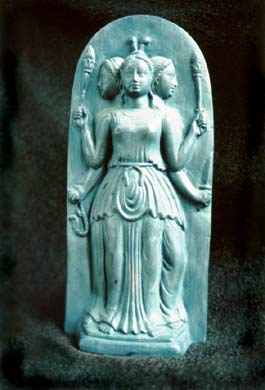The Divine Feminine
HECATE

Some say that Hekate is the daughter
of Erebus and Nyx, ageless Goddess of the night, while others believe that She
is one of the Furies or the last surviving Titan except for Zeus. Hesoid
claims that She was born of the Titan Perses and the star goddess Asteria.
Historically Hekate probably
originated in the mythology of the Karians in southwest Asia Minor, and was
integrated into Greek religion around the sixth century BCE. However, there is
evidence that Hekate evolved from the Egyptian midwife goddess Heqit,
(alternatively spelt 'Heket' or 'Hekat'.)
The frog headed
goddess Heqit assisted with the daily birth of the Sun and was associated with
the apparently magical germination of the seemingly lifeless corn seed. In
pre-dynastic Egypt the matriarch and wise woman of the tribe was called the 'heq'.
Hekate's name has several possible
meanings. 'She who works Her will' is the most commonly accepted, but 'the
distant one,' or 'most shining one' are alternative derivations. Representations
from around the forth century BCE show a young goddess of both beauty &
power, carrying a torch & wearing a headdress of stars. 'Hekate' is the
female equivalent of 'Hekatos', an obscure epithet of Apollo, with whom She is
sometimes associated.
The Olympians 'adopted' Her after they
had defeated the Titans, but She was not of the same kind, & never lived
amongst them. During this time Hekate's power was still recognized: Zeus gave
Her dominion over Heaven, Earth & Sea, & they shared the right to grant
or withhold gifts from humanity. Hekate was worshipped as Goddess of abundance
& eloquence, & She is still generous to those who recognize Her.
Hekate is sometimes referred to a
triple goddess. Classically She was part of a group with Persephone and Demeter.
Contrary to modern Pagan assumptions, Demeter represents the old crone woman,
Persephone the wife woman, and Hekate is the Maiden. Every early Greek
representation of Hekate shows Her as a young woman. It is only much later that
She is represented as Crone.
In Mytilene on the eastern coast of
the Aegean Sea, near what was Troy, there were Temples of Demeter, where the
women would go to the annual festival of Eleusis to celebrate fertility Rites.
There is ample evidence that Hekate was honored there too, perhaps as a guide
for initiates into the Mysteries.
But Hekate's power was to fade. In
later myths She is represented as a daughter of Zeus who rules the Underworld
& the waning Moon. The Greeks began to emphasize Her darker aspects; Hekate
as Goddess of the Dead & Queen of Witches. Now She roams the earth on moon
less nights in the company of baying dogs and the hungry spirits of those dead
who were not ready to die, those who were murdered or not given appropriate
burial rites.
The Romans adopted
Hekate, and Her role shifted again. Hekate became an aspect of the moon Goddess,
Diana Triformus: Diana (the Full moon, associated with Earth), Proserpina
(the lunar phases, associated with Heaven), and Hekate (the New moon, associated
with the Underworld.)
As the power of the Solar Gods rose,
Hekate became increasingly demonized, until by the Middle Ages She was reduced
to a parody of an evil crone.
Source: http://www.hecate.org.uk/history.htm
|

